-
Car Reviews
- All reviews
- Midsize SUVs
- Small cars
- Utes
- Small SUVs
- Large SUVs
- Large cars
- Sports SUVs
- Sports cars
- Vans
Latest reviews
- Car News
-
Car Comparisons
Latest comparisons
- Chasing Deals
Hyundai’s first-ever Tucson Hybrid has launched in Australia to conquest a growing appetite for hybrid family SUVs, but is it up to the challenge?
The facelifted Hyundai Tucson has its work cut out for it.
A massive 142,307 new mid-size SUVs have rolled off Aussie dealer forecourts so far this year – the biggest single segment in the Australian automotive market. Of that total, 9462 were Hyundai Tucsons – the brand’s biggest-selling vehicle locally in 2023, and to the end of June in 2024 too.
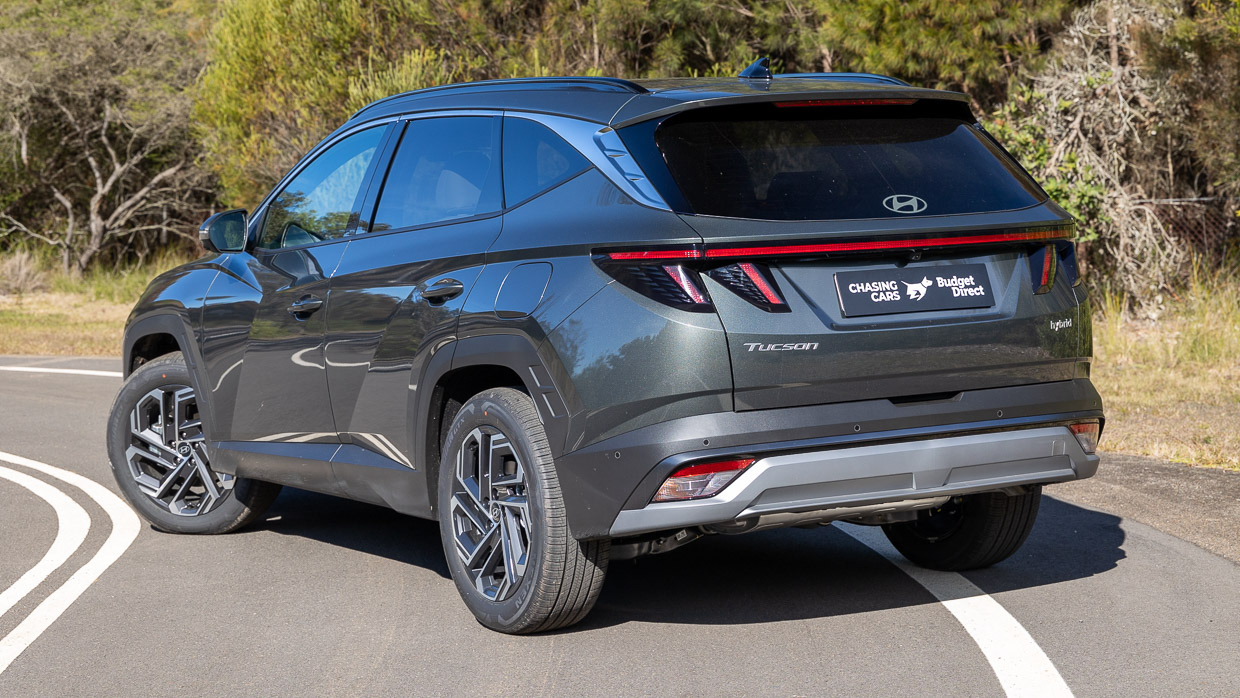
But, while it’s still selling well, the Tucson currently sits fifth in its segment behind the Kia Sportage (10,474), Mazda CX-5 (11,920), Mitsubishi Outlander (14,443), and the segment-dominating Toyota RAV4 (25,405).
Granted, Hyundai has been constricted by supply this year, but irrespectively, the Tucson operates in a fiercely competitive market. And that market is evolving in terms of buyer tastes and habits. Significantly, the segment-dominating RAV4 is now hybrid-only across its entire range.
Within that context, the first-ever Tucson Hybrid – the headline powertrain of the newly facelifted fourth-generation range – arrives on Aussie shores to conquer a growing appetite for hybrid mid-size family SUVs. Yet this new powertrain isn’t the only change for the Tucson for 2024.
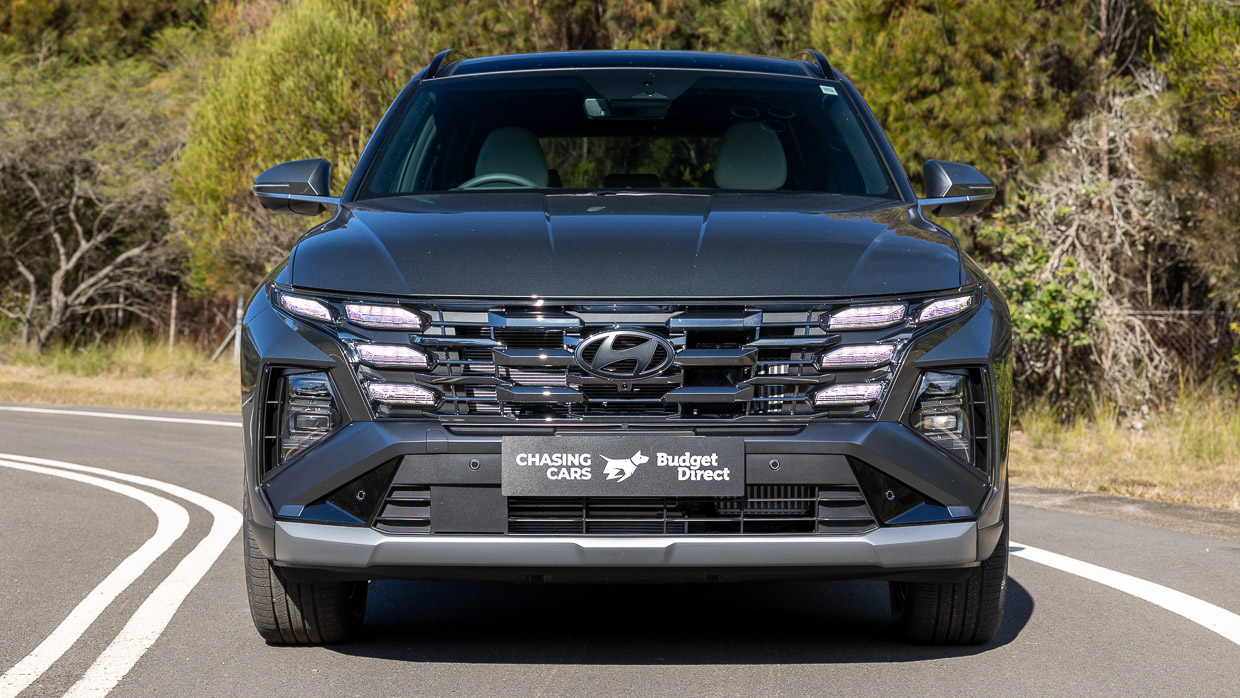
The facelift introduces some subtle exterior updates across the entire range – tweaks to the front fascia, including modifications to the grille, lights and bumpers, redesigned alloy wheels on every variant, and at the rear there are revisions to the tail-lights, badges and bumper.
For a design that appeared in 2020, this reviewer thinks the fourth-gen Tucson still looks pretty fresh, though apart from under the bonnet, it’s inside where big changes have been made, as we’ll discover.
Are these changes enough to give the Hyundai Tucson the competitive edge it needs to conquer its foes? Or will it be a David and Goliath battle against colossal Toyota RAV4 sales?
Unsurprisingly for the market’s most popular segment, Hyundai offers 17 Tucson variants! So you definitely won’t be short on choice. But before we tackle features, let’s tackle the range.
Firstly, there’s the choice between three variant grades – Tucson, Tucson Elite, and Tucson Premium, with the latter replacing the previous top-spec Highlander grade.
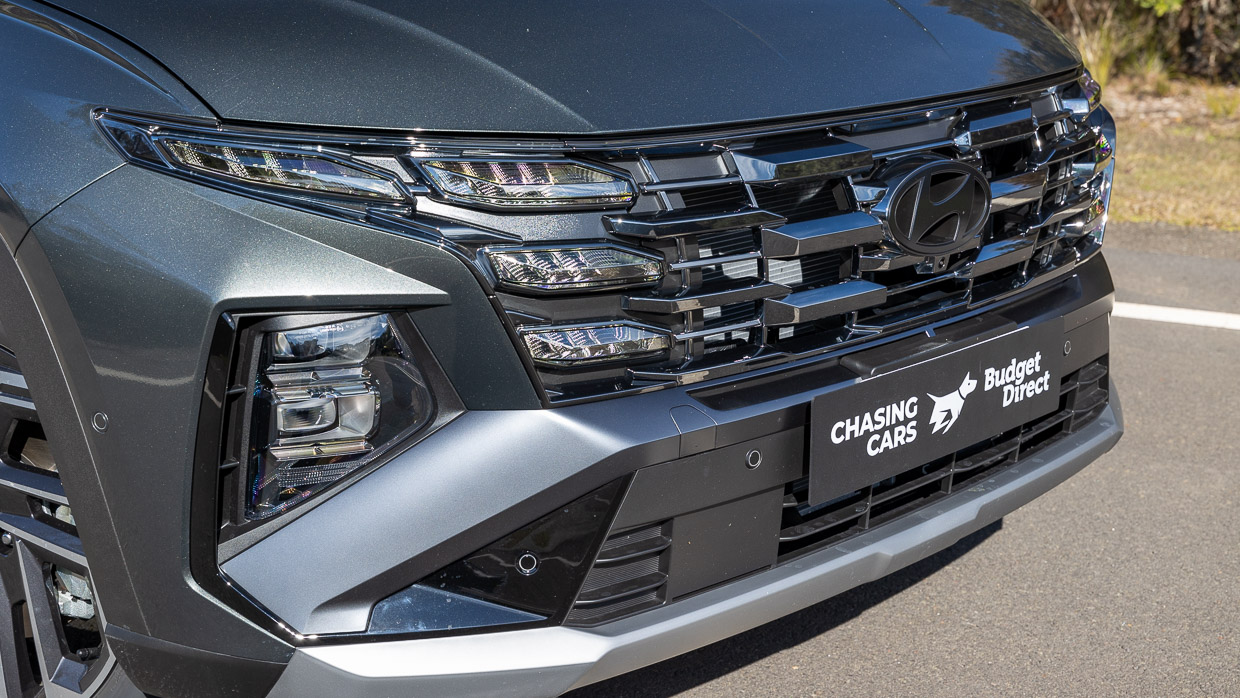
You can then choose whether you opt for a sporty N-Line package for an additional $2500 that brings with it features like N-Line-exclusive wheels, bumpers and badging on the exterior, plus black headlining, black leather and suede seats, red stitching and N-Line emblems inside. The N-Line pack is only available on turbo-petrol and hybrid models.
Then you have the choice of powertrain.
The first option is a naturally aspirated 2.0-litre petrol four-cylinder with front-wheel drive, mated to a six-speed torque converter automatic transmission, delivering total outputs of 115kW/192Nm.
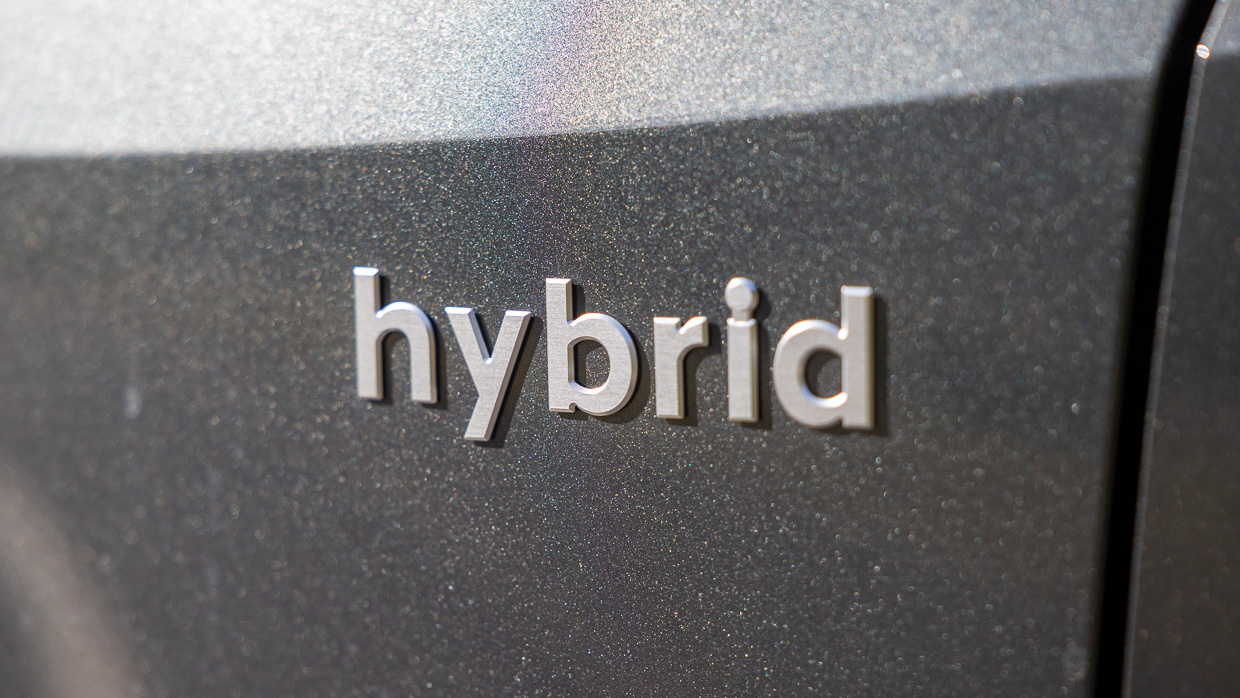
Or you can select a more powerful turbocharged 1.6-litre direct-injection four cylinder mated to a seven-speed dual-clutch automatic transmission, with either front-wheel drive or all-wheel drive. This powertrain’s outputs are 132kW/264Nm.
Unfortunately for fans of the pre-facelift turbo-diesel – which included Chasing Cars – it’s now been discontinued. Instead, the facelift brings a new powertrain option in the Tucson Hybrid.
The Hybrid is the most powerful facelifted Tucson – mating the 1.6-litre turbo-petrol engine with a 47.7kW electric motor and 1.49kWh, 270V lithium-ion polymer battery, which achieves total outputs of 172kW/367Nm.
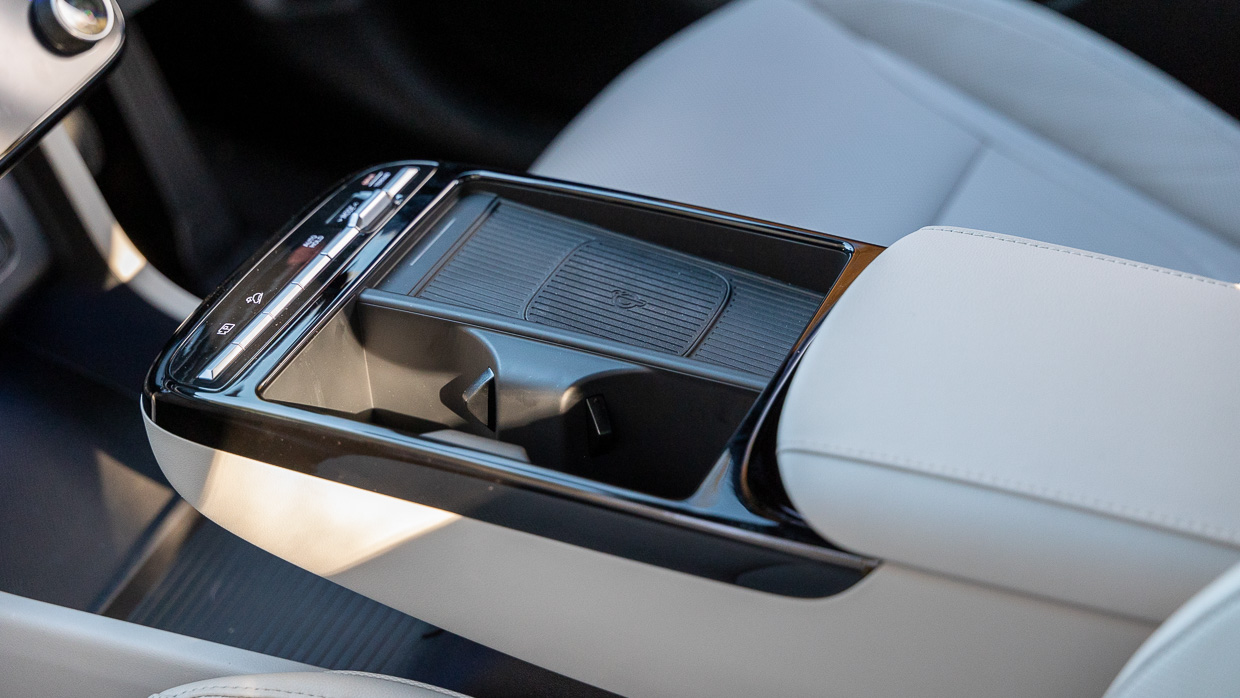
In terms of specs, standard features across the Tucson range include:
Stepping up to the Elite adds features such as:
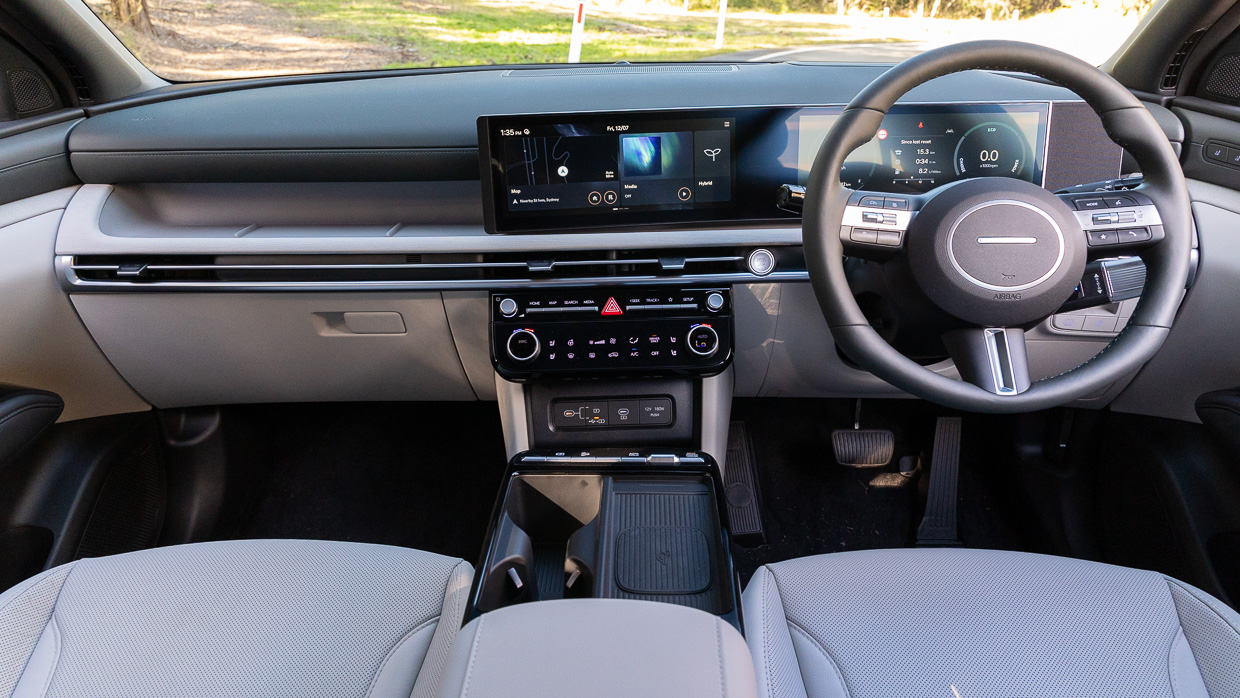
The Premium adds features such as:
So there’s a lot of choice, and choice is good, but the facelift also brings price hikes.
Cost of entry is up by about $3000 to $39,100 before on-road costs for the base Tucson 2.0-litre.
The most affordable Hybrid is $45,100 for the entry-level model, which can only be specified with front-wheel drive.
Stepping up to the Elite and Elite Hybrid brings the option of front- or all-wheel drive, with Hybrids asking a $4000 premium over their respective 1.6-litre turbo variants across the range (though there is an Elite 2.0-litre version for $44,100).
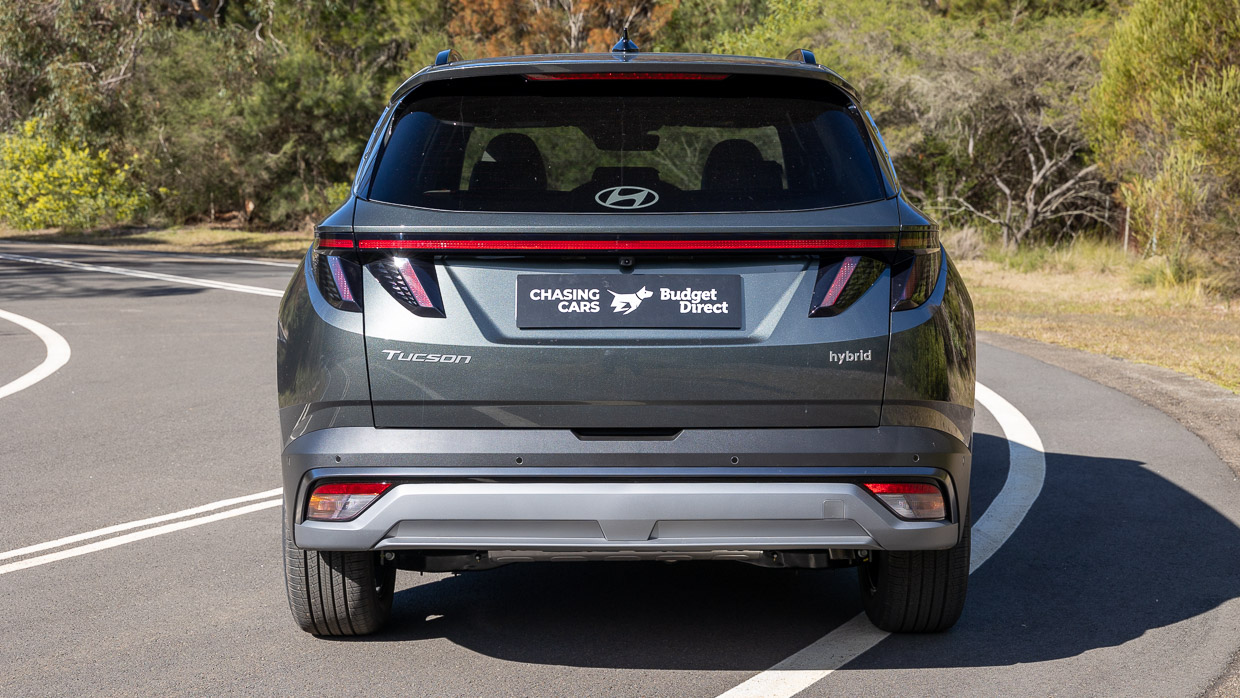
But today we’re focused not only on the hybrids, but specifically the Premium Hybrid AWD which will set you back $59,600 before on-road costs, $1500 below the top-of-the-range Premium with N-Line package.
Our test vehicle costs about $66,000 drive-away, which includes optional pine green matte paint (+$1000), as well as a two-tone interior (+$295).
Some may squirm at that asking price for what is marketed as an attainable mid-size SUV, but the likely defence from Hyundai would be that they are offering choice across a broad 17-variant range, top-spec Tucsons have traditionally always sold well, and this update comes with all the fruit.
Not only that but the high-$50K/low-$60K mark is generally where the market sits in terms of top-spec hybrid competitors from Kia, Honda, Nissan and Toyota. It’s also important to note the Tucson is available with all-wheel drive, which does not apply to all of its competitors.
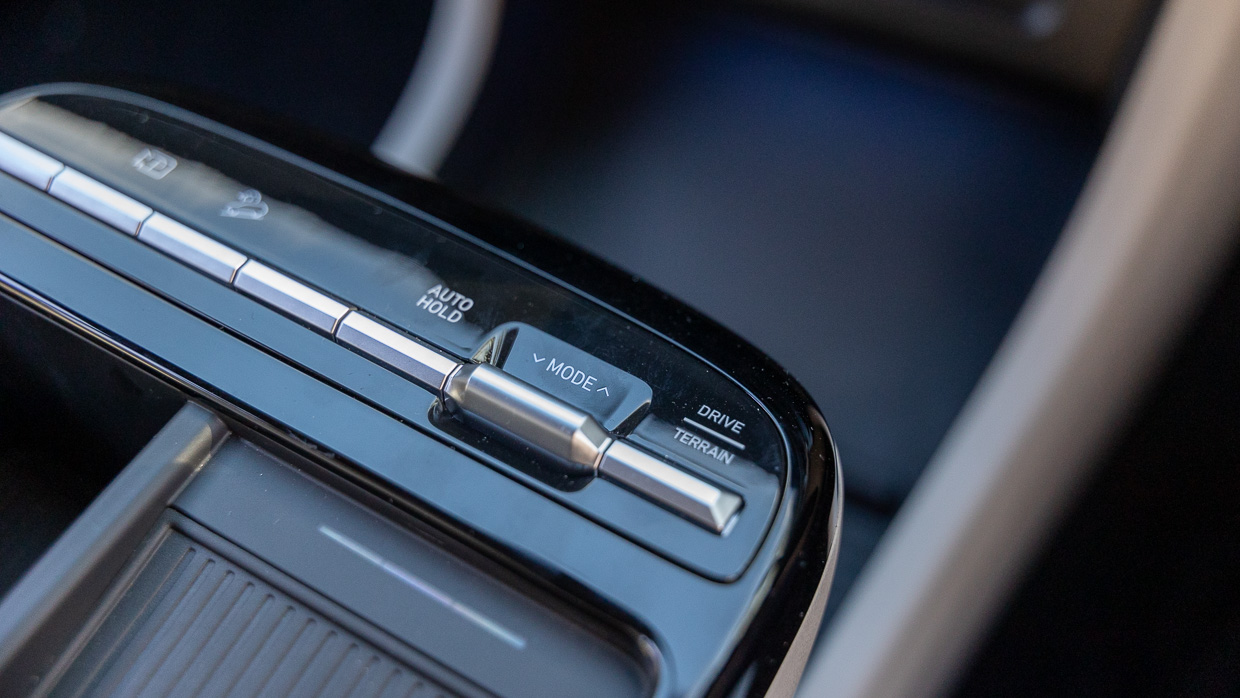
Tucson Hybrid variants also come with a few additional features over the pure-petrol variants, including what Hyundai calls ‘e-Motion Drive’ – an electric dynamic torque-vectoring control system designed to help with stability and handling by reducing inside wheel slip when cornering.
They also get Auto Terrain Mode which allows you to switch between different terrain modes – snow, mud and sand, or keep it in auto which Hyundai says uses AI to recognise the road surface.
And there’s also ‘baby mode’ that helps modulate acceleration and torque to make it smoother for infant, as well as smart regenerative braking.
If you’ve read previous Chasing Cars reviews of the current-generation Tucson before the facelift, you’d know that the team were already fans of the Tucson overall, but with a preference for the diesel engine for delivering the best drivetrain combination.
It coupled a 2.0-litre turbo-diesel with an eight-speed torque converter automatic, delivering total outputs of 137kW/416Nm, which was previously the most powerful option you could get.
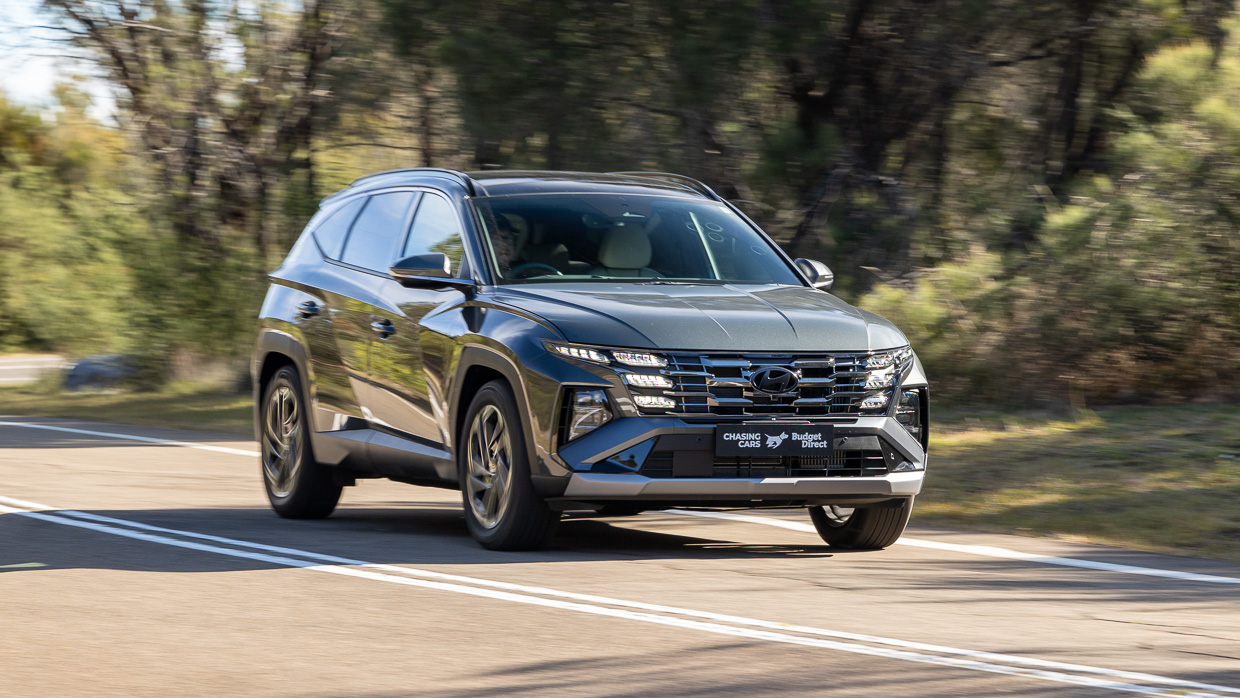
But with diesel now gone, is the hybrid the new sweet spot in the range?
Note that the hybrid is the only fourth-gen Tucson variant I’ve driven, so I can’t directly compare it with the diesel or its pure-petrol siblings, but on paper the hybrid makes a strong case for itself.
Crucially, you aren’t just paying more for better economy. It offers 40kW more power and 100Nm more torque than the non-hybrid turbo-petrol, but you’re also getting significantly more power than the diesel, if not quite as much torque.
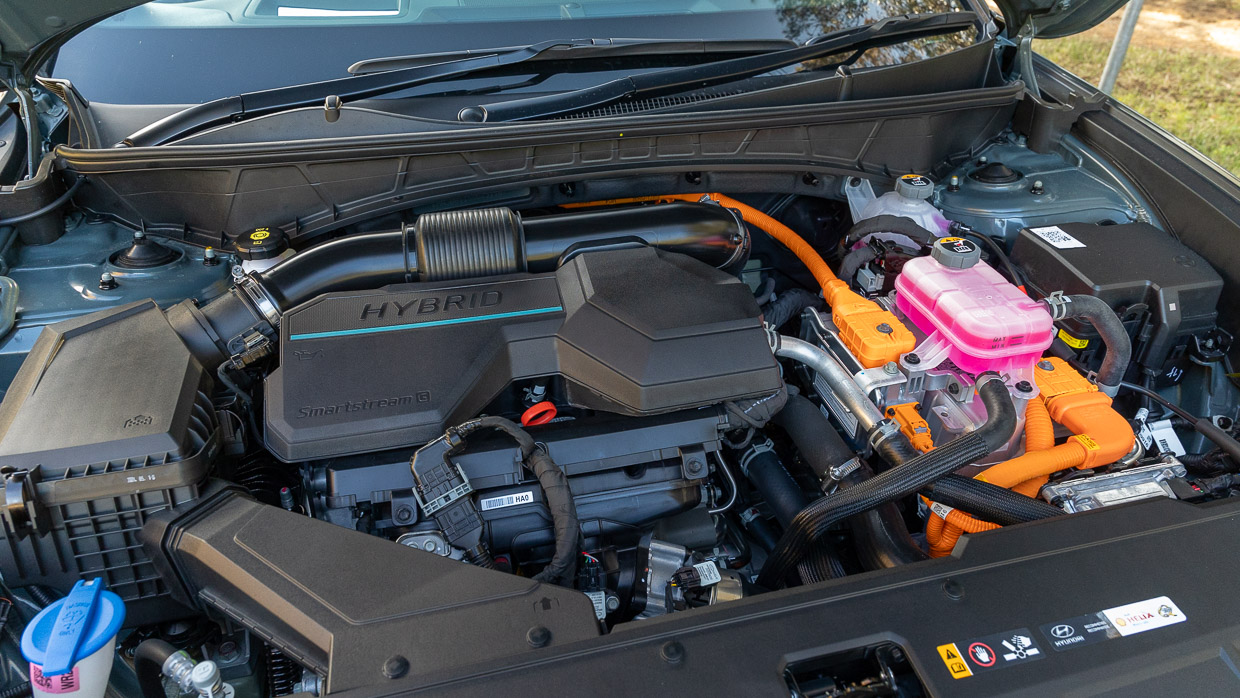
So how does it go in practice?
Pretty well overall. The Tucson Hybrid feels very decently powered, and the AWD system gets power to the ground briskly, though I find it’s at its best when driven smoothly – not thrashed.
That might sound obvious as this is a family SUV, but in a few moments of putting my right foot to the floor during country and highway testing, there were occasional moments of lag before the powertrain responded.
Drive it smoothly, however, and there’s more than adequate performance and response for everyday needs.
For the most part, the Hybrid’s six-speed auto shifts smoothly. It’s not the sportiest of transmissions but it seems to pair well with the 1.6-litre petrol-electric powertrain.
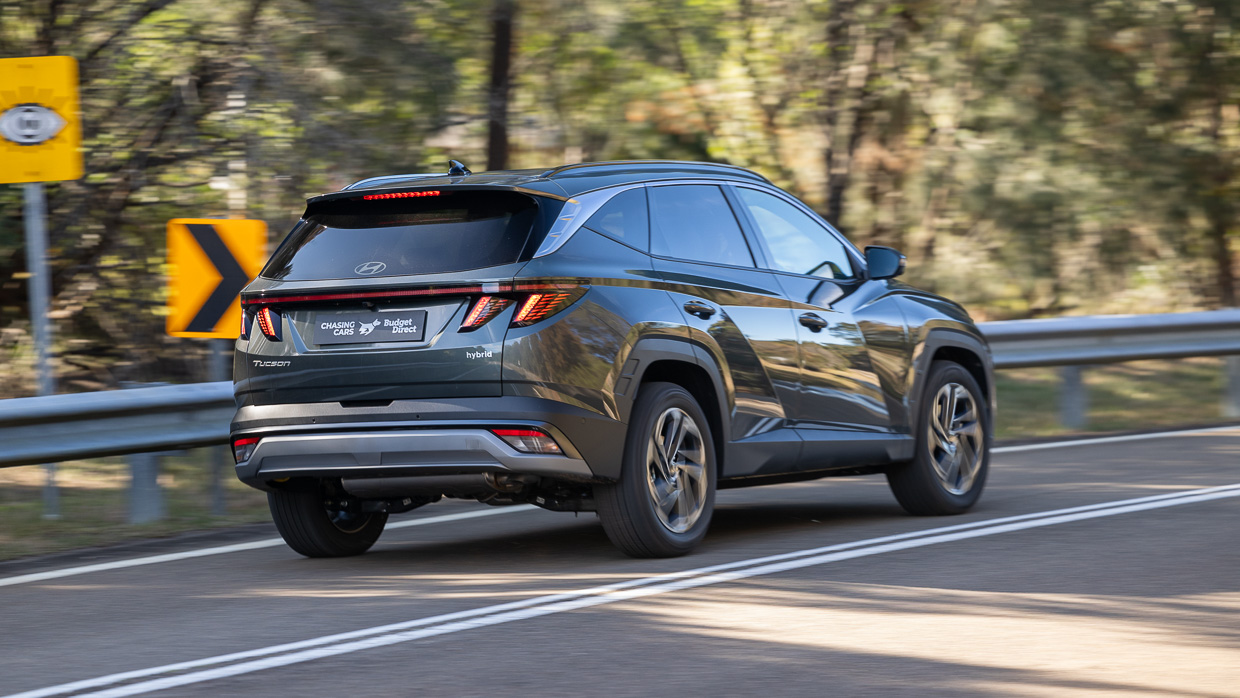
It’s worth noting that most of the Tucson’s hybrid competitors (bar the Kia Sportage) come with CVT transmissions instead of conventional torque-converter autos, so this is something to keep in mind if you aren’t a CVT fan.
In terms of ride and handling, it’s a positive story.
Our launch-drive stint included a very decent drive loop from Sydney to the Hunter Valley on a mixture of urban, highway and country roads, as well as a decent chunk of unsealed gravel and dirt roads. That meant that we were able to drive the Tucson in a wide variety of conditions, and a bit harder than it’s probably intended to be driven when acting as a family-hauler.
The Tucson comfortably tackled everything in its path. In previous reviews we’ve noted the Tucson’s good-quality ride, and that was certainly my impression on the launch route.
As well as driving the Premium AWD on 19-inch wheels, I also had a stint in the Elite Hybrid wearing 18-inch wheels, and the ride quality and compliance provided by both variants felt impressively absorbent on some pretty sketchy roads with plenty of potholes and bumps.
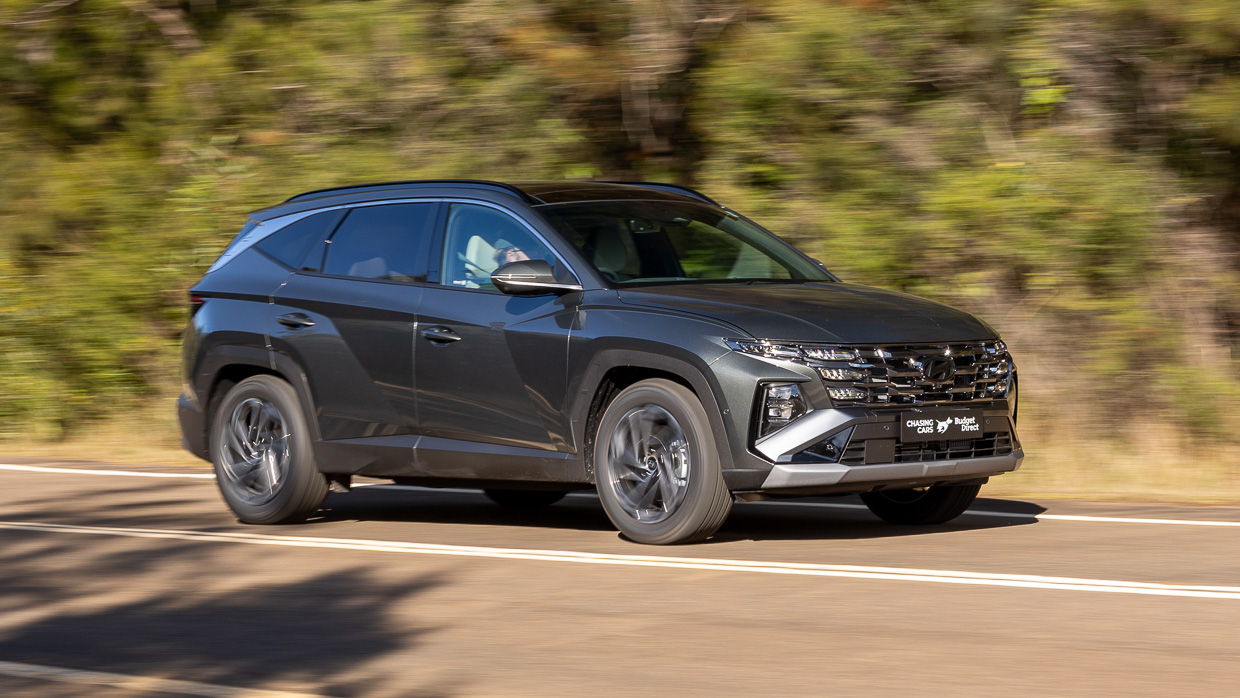
The Tucson Hybrid remained composed and controlled in all scenarios – nicely planted on both winding roads and motorways, and realistically more than capable for daily driving needs.
The steering, while not the last word in feel or feedback, felt light and natural, and I’m a big fan of Hyundai’s modern steering wheels with the four morse-code dots replacing the brand’s traditional logo.
While I spent most of my time in the all-wheel drive, I did also have a short stint in the front-drive Hybrid which also performed well on the whole.
However, I did have one moment where it struggled for a bit for off-the-line traction under hard acceleration.
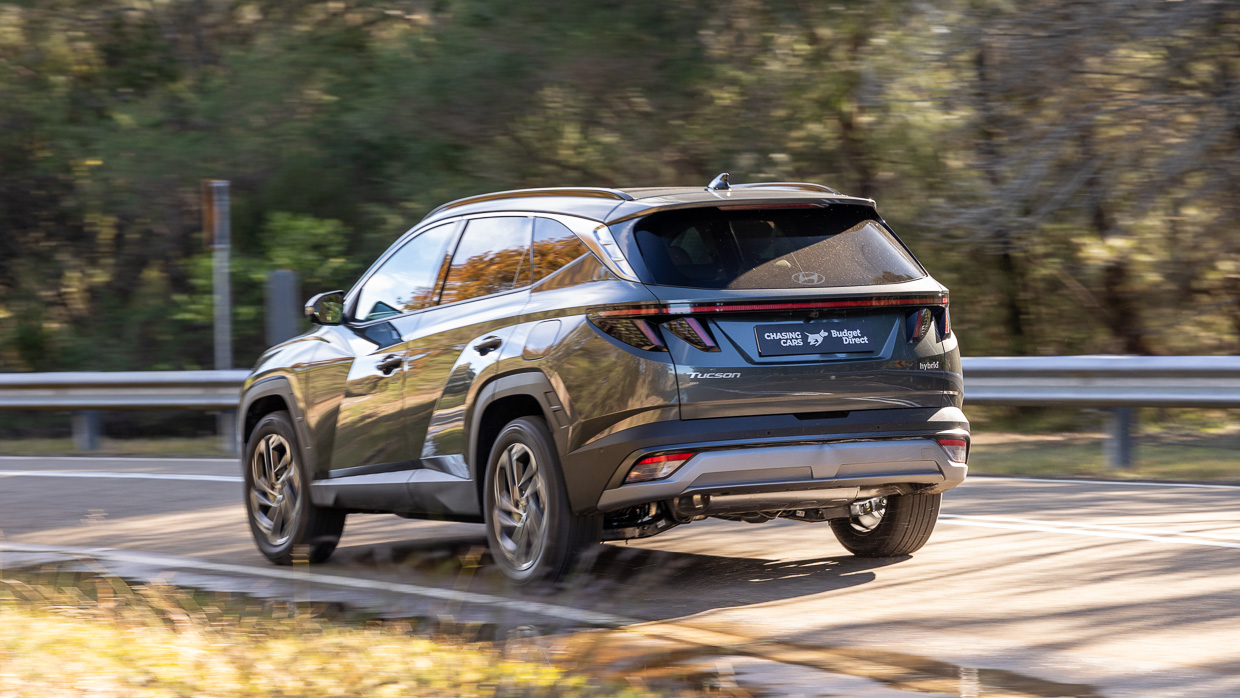
It wasn’t alarming and recovered well, and for the most part I don’t imagine many people would notice the difference between front- and all-wheel drive in most situations, but the added surety of all-wheel drive is appreciated in challenging situations, noting that it’s an on-demand system, not permanent all-wheel drive.
Again, the fact that the Tucson Hybrid is available with all-wheel drive is a positive. The Kia Sportage Hybrid and Honda CR-V E-HEV RS are front-drive only, leaving the Toyota RAV4 Hybrid, Nissan X-Trail E-Power and Subaru Forester Hybrid as key AWD competitors.
However, the Kia Sportage does still offer a turbo-diesel variant with AWD.
In terms of refinement, the Tucson makes a good initial impression. Its cabin feels well-insulated and the smoothness of its hybrid system is impressive, with imperceptible transitions between petrol and electric propulsion for the most part.
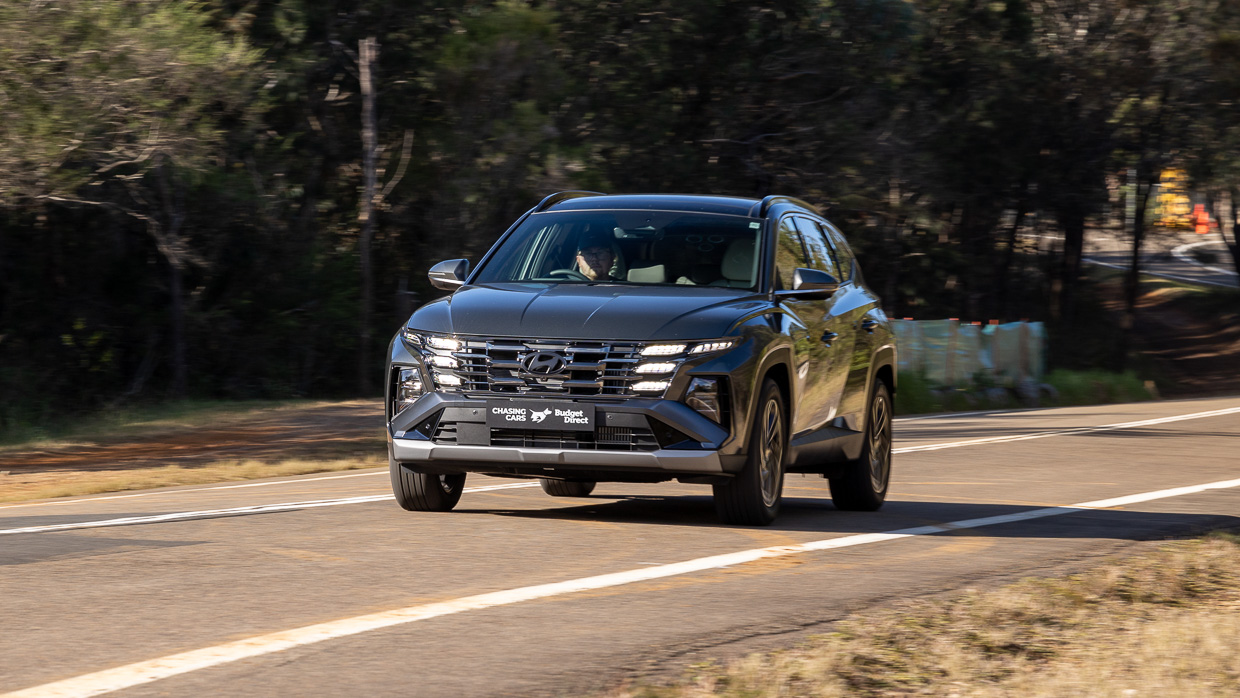
Its brakes feel strong and easy to modulate, and you can also take advantage of the regenerative braking on offer. As with Hyundai’s full EVs, you can use the paddles on the steering wheel to shift between different levels of regenerative braking, which is nice to have on the Hybrid.
Or if you want to liven things up, you can switch to ‘Sport’ mode, changing the function of the paddles so that you can use them to shift gears yourself.
Another strong point for the Tucson is its relatively robust 1900kg braked towing capacity compared to its hybrid competitors. This is the highest claim of the Tucson range and more than its RAV4, X-Trail, CR-V and Sportage hybrid competitors.
Of course, if towing is an important consideration then a non-hybrid mid-size SUV like a Volkswagen Tiguan delivers a 2500kg braked capacity, but in terms of the hybrids – 1900kg makes Tucson the benchmark.
While exterior changes are minimal for the facelifted Tucson, interior changes are significant. In essence, the design has been brought into line with other Hyundai models, including the brand’s familiar dual-pane instrument and media display screens, and the overall improvement is a definite step forward.
To my eyes, the updated design appears elegant and nicely resolved.
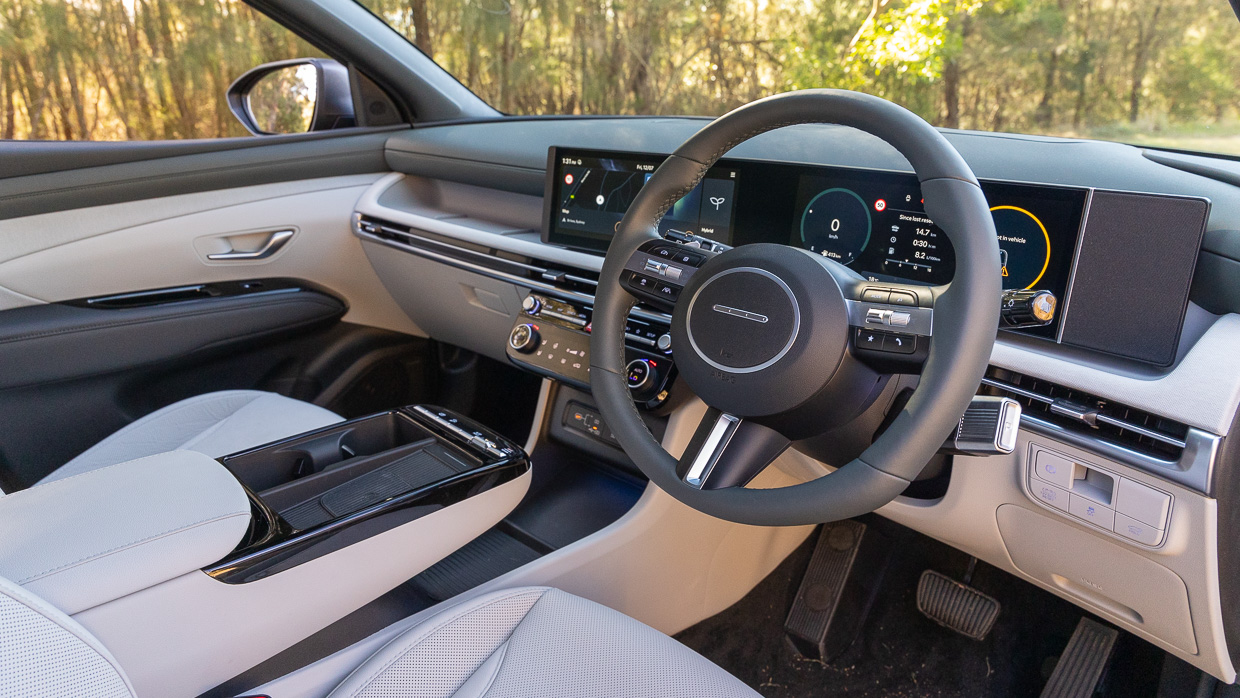
The graphics of the digital instruments and media display are clean, crisp and simple, and it’s all quite intuitive to use. I also like that the graphics have a flat 2D design with not too much going on – a welcome contrast compared to the proliferation of busier graphic arrangements out there.
The infotainment, which is equipped with wireless Apple CarPlay and Android Auto, also works intuitively and responsively.
However, I find I always need to lean slightly forward to interact with the touchscreen, and this may just be a personal criticism due to my preferred driving position.
This is something I’ve noticed in many other car brands, which is why I appreciate it when manufacturers (such as some BMWs and Mazda) offer a rotary dial controller in addition to a touchscreen, though I know not everyone is a fan.
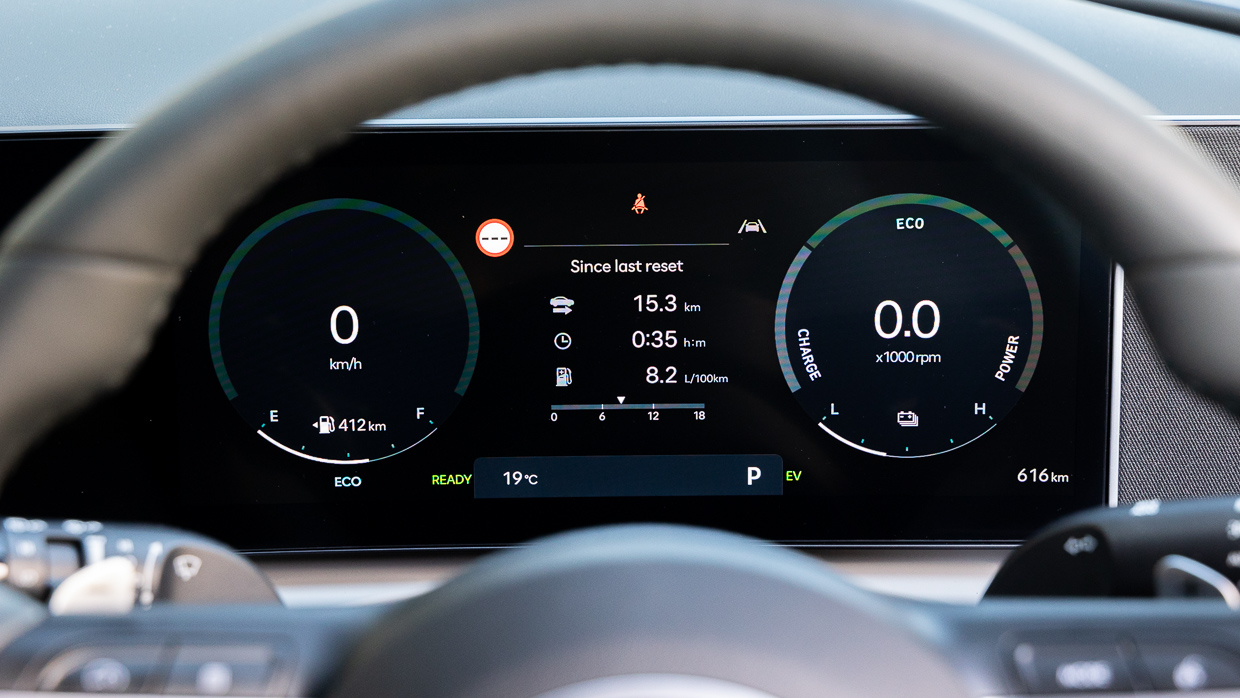
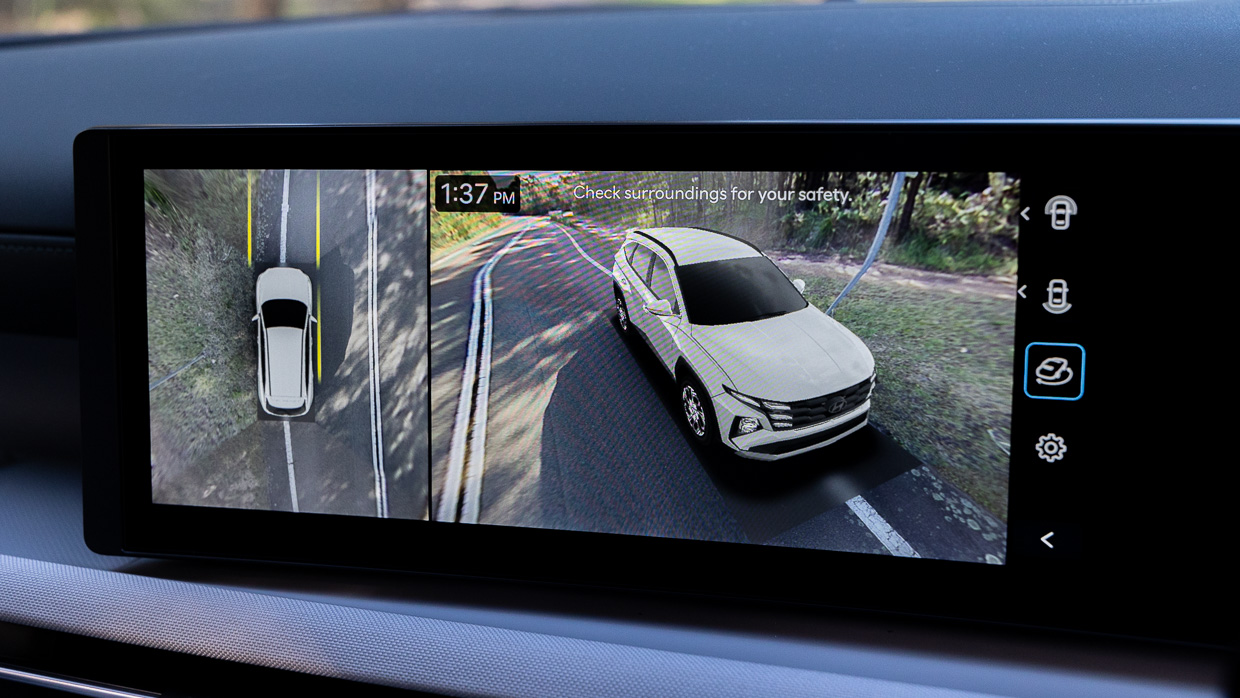
Yet the cabin generally works very well ergonomically. The climate controls are simple and the Tucson retains physical dials to adjust the temperature, and while it relies on touch buttons for other climate functions, they’re always illuminated and easy to access; no menu hunting required.
In terms of comfort, Tucson’s seats are nicely supportive, offering lots of adjustment and good visibility.
Storage is also good – there’s a decently sized central cubby in addition to the glovebox, and an open shelf area above it as well as an open area where you’d normally find the gear-shifter, which has migrated to a column-mounted shift-by-wire selector as in other Hyundai models.
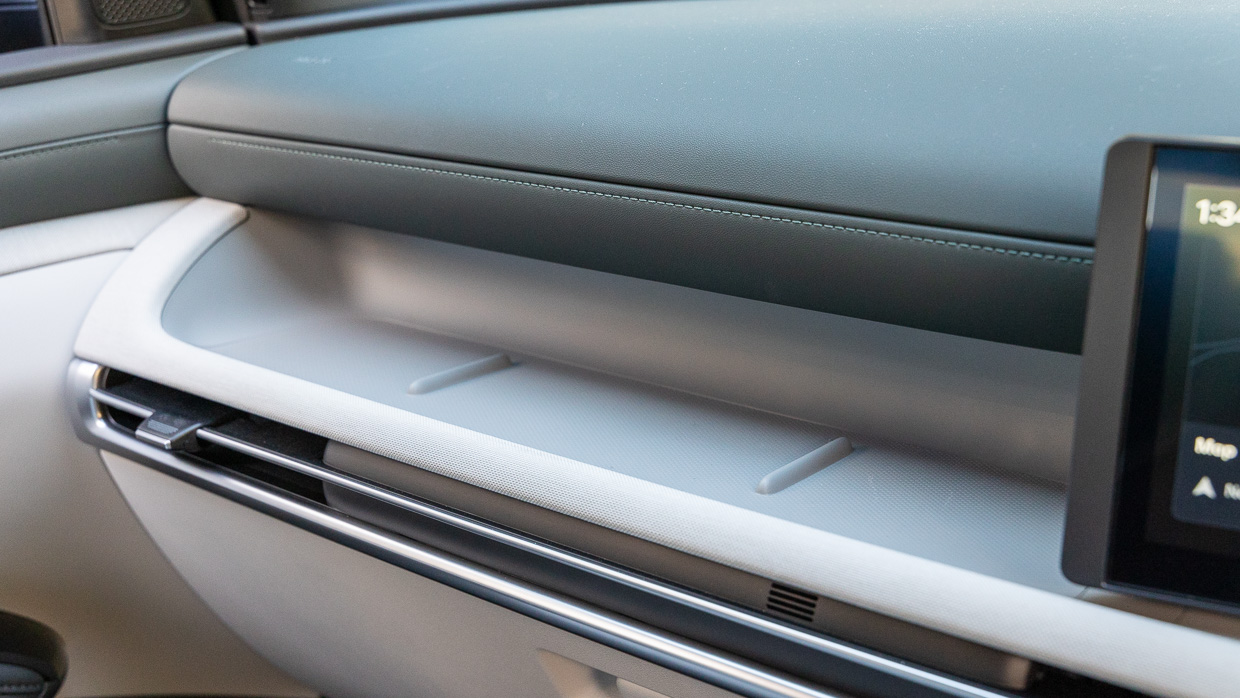
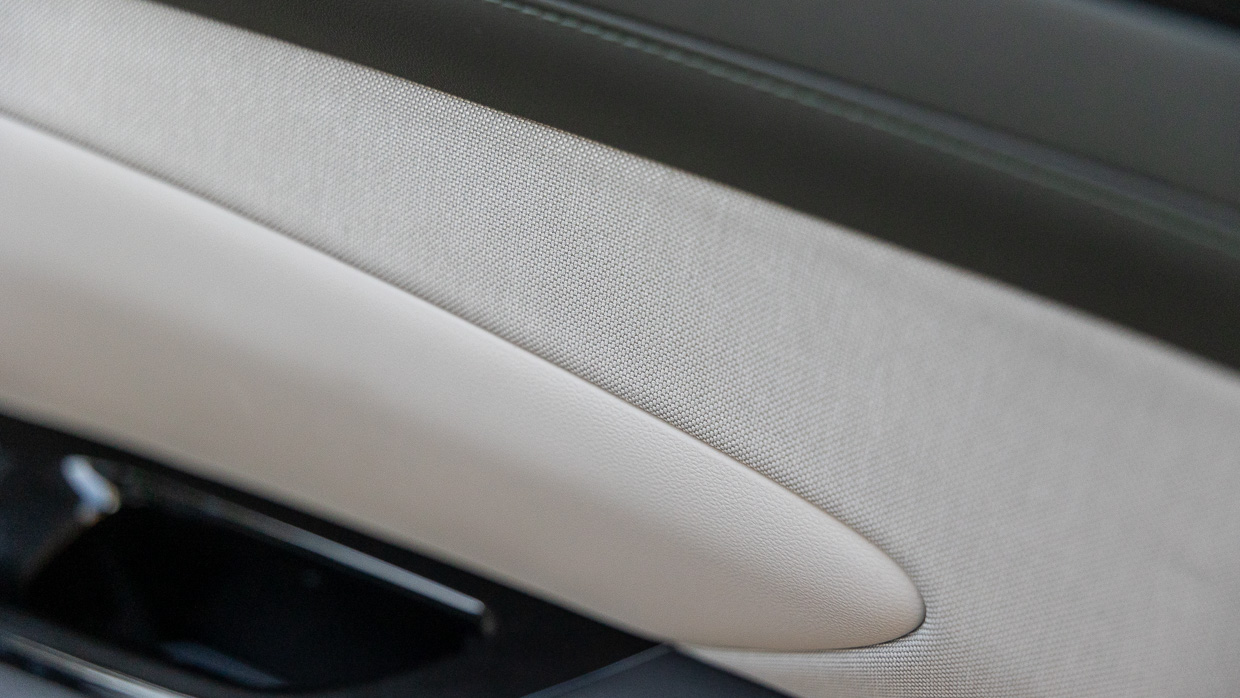
I’ve used this shifter quite a lot now – mainly on my long-term Kona – and am getting used to it. I like what it enables ergonomically in terms of economising on space, but on occasion I still have a moment where I twist it the wrong direction, despite Drive being essentially a twist forward and reverse a twist to the rear.
Overall, new Tucson’s cabin has some hard materials, and I wouldn’t call it plush – but it’s elegant, well-presented, and feels solidly built and screwed together quite nicely indeed.
The fact our test car was optioned with a two-tone Dark Green/Grey interior for $295 did help achieve a light and airy cabin ambience. You can also option a black/grey combination if that’s your preference or stick with the standard black, depending on exterior body colour choice.
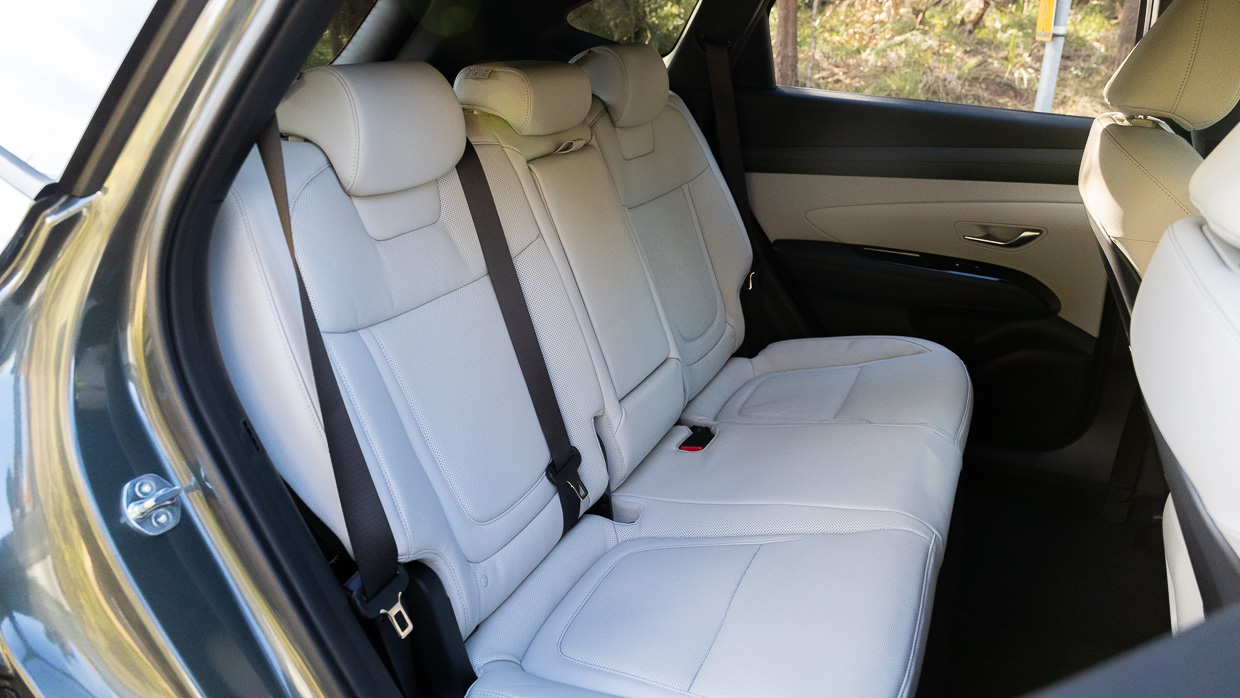
In the back, rear-seat space is decent, with good legroom and reasonably good toe and headroom for me at 183cm.
The rear seat is comfortable and the backrest reclines, plus there’s features such as rear air vents, map pockets on either side, two USB-C ports and a fold-down centre armrest. Heated rear outboard seats on the Premium are also appreciated.
Overall ambience is pleasant, apart from some hard, scratchy plastics on the rear door tops.
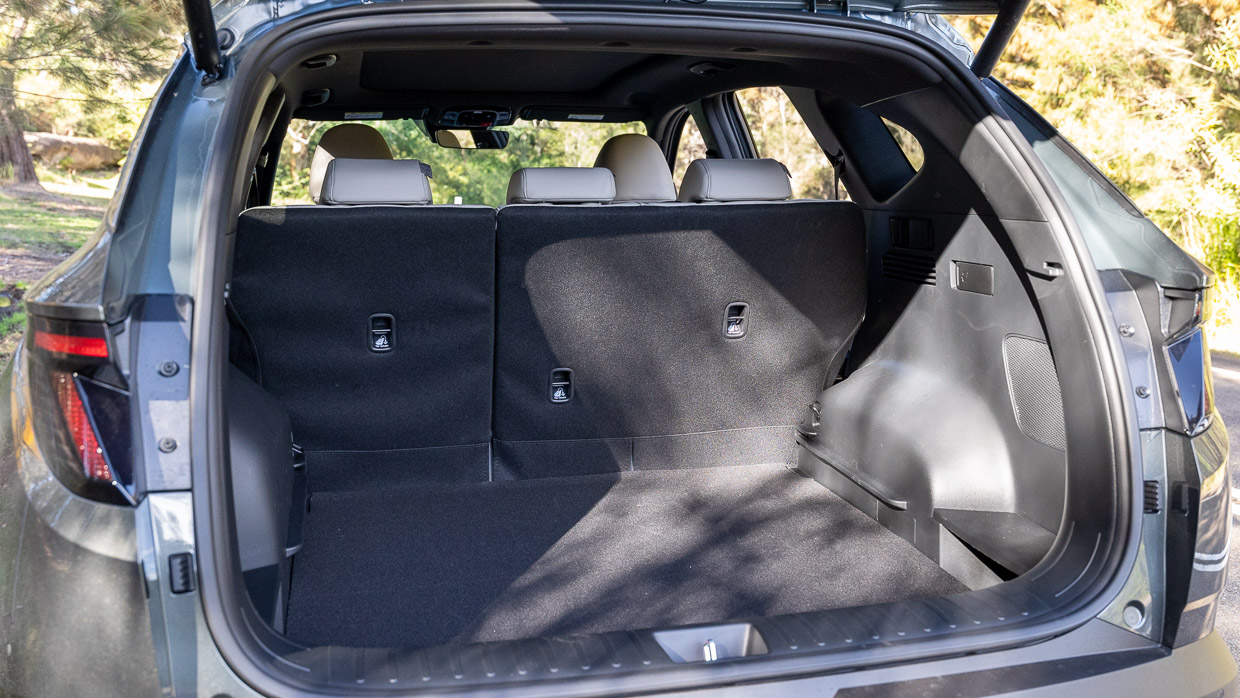
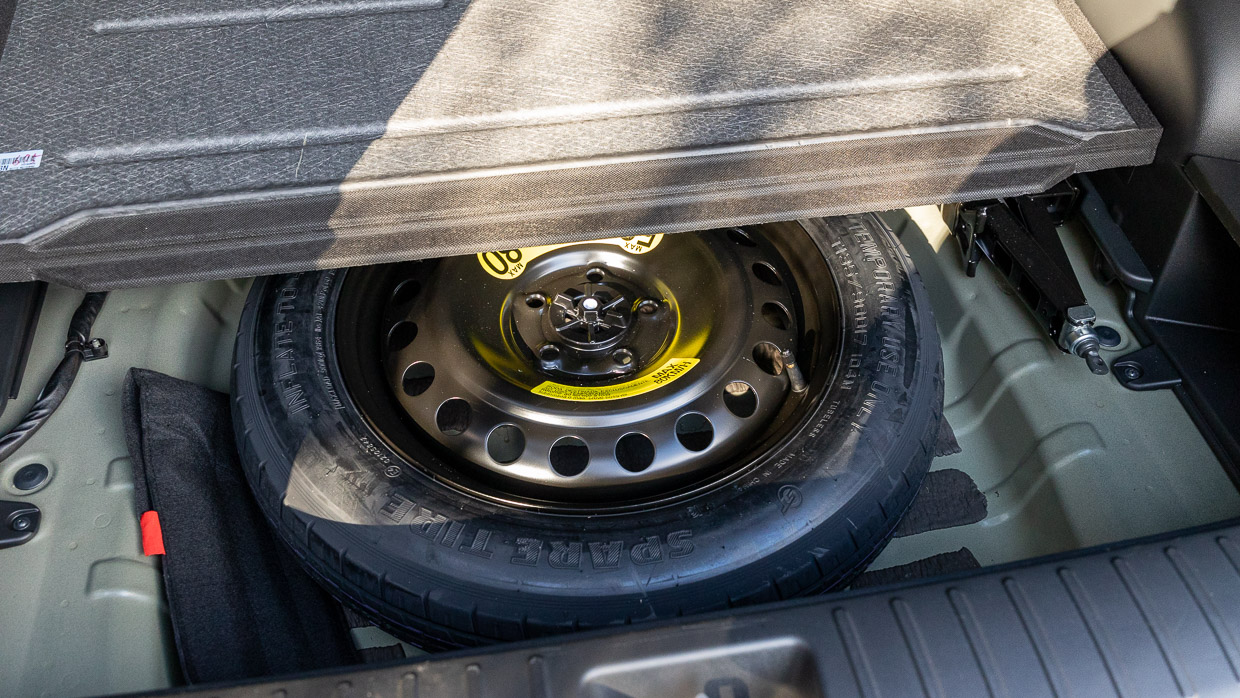
Boot space is also solid at 582 litres, which is pretty much in line with its main hybrid competitors (RAV4, Sportage, CRV and X-Trail). There’s also 1903 litres with rear seats folded down.
Beneath the boot floor, however, there’s an extra selling point – a space-saver spare.
Granted, it would be nicer if it was full size (like non-hybrid variants) but the fact the Hybrid offers any kind of spare wheel is good – just ask Production Specialist Tom Place who had to put his previous Nissan X-Trail E-Power long termer on the back of a tow truck after it got a puncture.
The fourth-generation Tucson achieved a five-star ANCAP safety rating when it was crash tested in 2021, the rating set expire in December 2027.
It also comes loaded with a suite of other active- and passive-safety features including:
In practice, I used the adaptive cruise control quite a bit on our launch drive and found it worked well on a decent highway stint.
Notably, Hyundai has also rolled out a change to its flawed Intelligent Speed Limit Assist which sounds an audible warning whenever it detects that the vehicle is going over the speed limit.
This feature has been criticised for its overzealousness in other Hyundais, in particular when occasionally getting the speed limit wrong or when it beeps while driving in a school zone outside of school-zone hours.
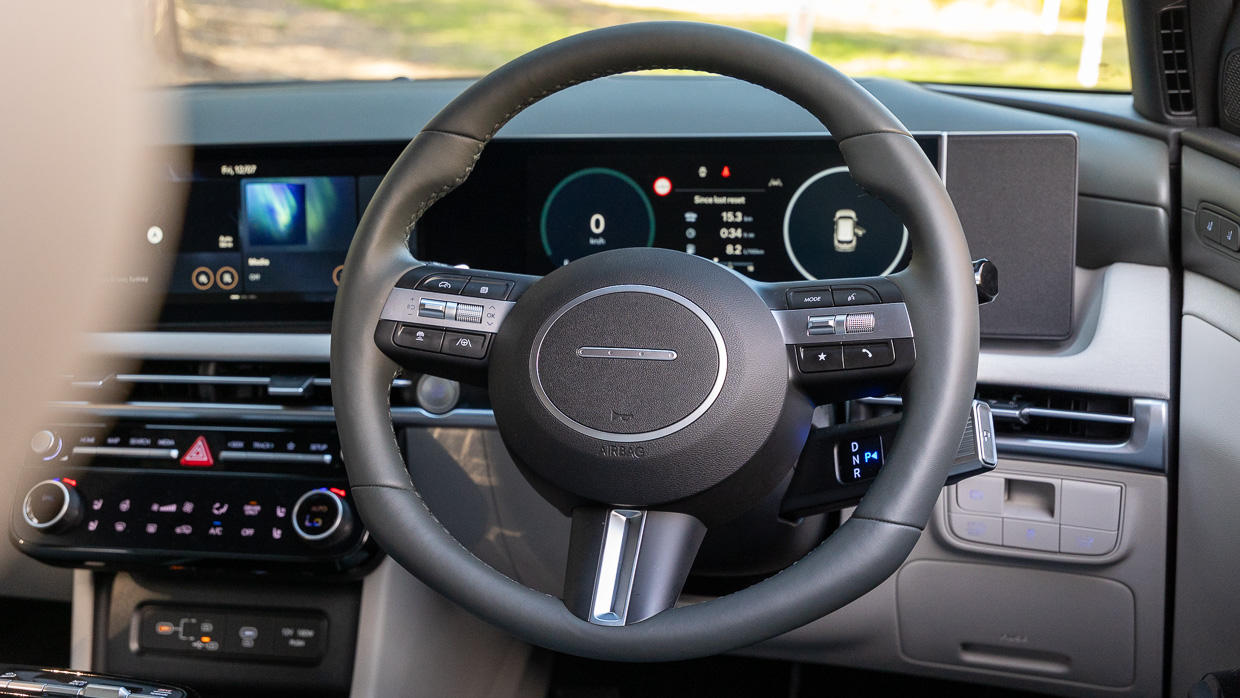
In my long-term Kona, the system can be switched off in a minimum of three actions when using a shortcut function, however the new Tucson allows you to hold the mute button on the steering wheel for five seconds – switching the audible warning off in one action.
While Intelligent Speed Limit Assist has received much criticism from automotive journalists in particular, Hyundai says that many customers like the feature, but acknowledge there were enough complaints to justify this adjustment.
The Tucson Hybrid range is covered by Hyundai’s five-year, unlimited-kilometre warranty.
Service intervals are every 12 months or every 10,000km, and five years of servicing will cost you $2040. That’s cheaper than the Kia Sportage though not as cheap as the $1300 and $995 that the RAV4 and CR-V charge respectively over the same time period.
But the big question is fuel efficiency – that’s why we buy hybrids, right?
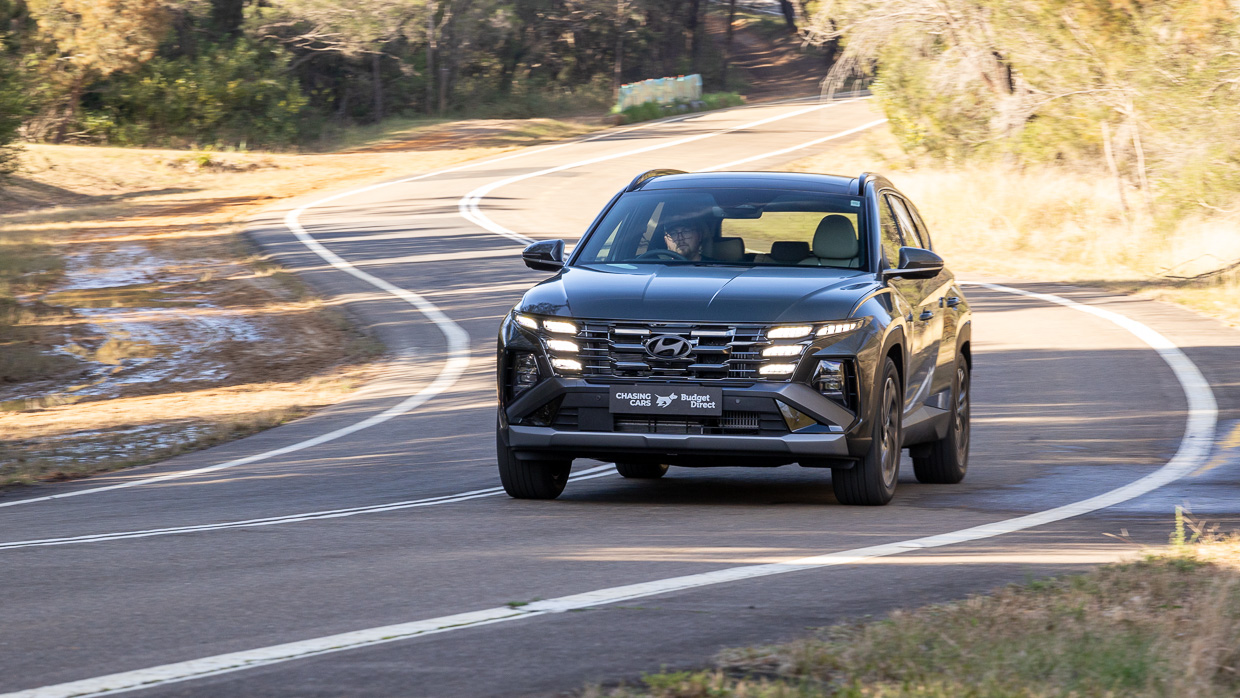
The official combined consumption figure for the entire Tucson Hybrid range is 5.3L/100km. That’s irrespective of front- or all-wheel drive, despite the hybrid AWD weighing about 60 kilos more than its front-drive counterpart.
For comparison, the regular turbo-petrol AWD’s official combined figure is 7.2L/100km. It weighs about 90 kilos less than its hybrid equivalent.
Based on an average cost of fuel at $2/litre and an average of 15,000km travelled per year, it would take an owner seven years to make up the $4000 price premium for the hybrid. But this doesn’t take into account that you’re getting more than just fuel efficiency gains by going for the hybrid; you’re also getting more grunt and some additional hybrid-only tech and features.
In terms of real-world results, a 150km stint in the Premium Hybrid AWD starting on country roads, but mainly driving on the highway from the Hunter Valley into Sydney, delivered an average of 6.1L/100km.

A shorter 41km stint on country roads in the Elite AWD, driving moderately, delivered my best result of 5.4L/100km, which is very close to matching the combined claim.
Lastly, a stint in the Premium Hybrid AWD N-Line across 110km from Sydney out to the Hunter region using a mixture of Eco and Sport drive modes – inclusive of urban, highway, and lots of country roads, dirt, gravel, and harder driving – expectedly delivered the worst result of 7.9L/100km.
As these are all initial launch drive results based on the vehicle’s trip computer, we’ll save our final assessment on efficiency for when we can conduct a proper fuel efficiency test over a longer-term road test.
On initial impression, the Tucson Hybrid certainly appears to be a promising mid-size hybrid SUV.
It presents well, it’s easy to drive, comfortable, has an elegant interior, an expansive range, and it doesn’t seem to deliver any noticeable shortfalls compared to its main competitors.
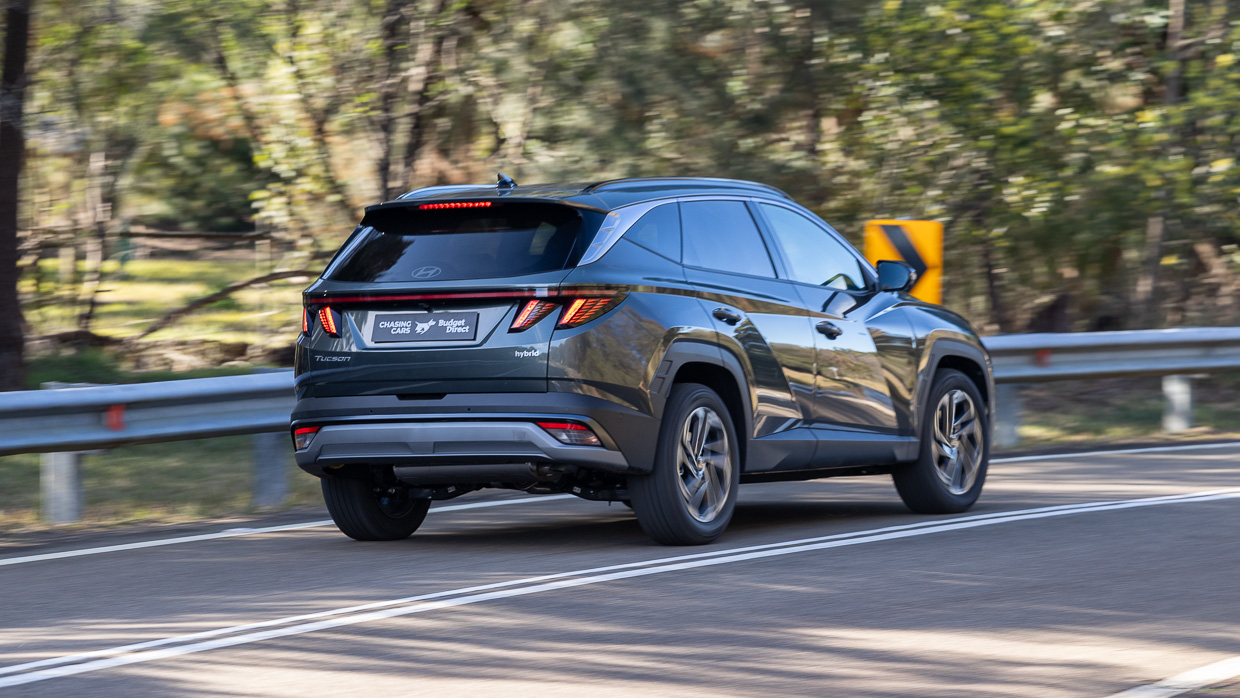
Certainly, it seems to make a pretty solid case for itself as a family-sized SUV that should be considered alongside its main competitors.
This is especially true when you consider the fact that it offers an appealing combination of hybrid-turbo power, all-wheel drive, a spare wheel, and relatively strong towing capacity compared to key hybrid rivals. This might give it the edge for some buyers.
Is the Premium AWD the sweet spot? It’s certainly a fine-riding family SUV and all of its additional features and interior class are appreciated – albeit for a price. However, we’ll save our definitive assessment on that until we spend more time a bit lower down in the range, and compare the new Tucson Hybrid back-to-back with its key rivals.
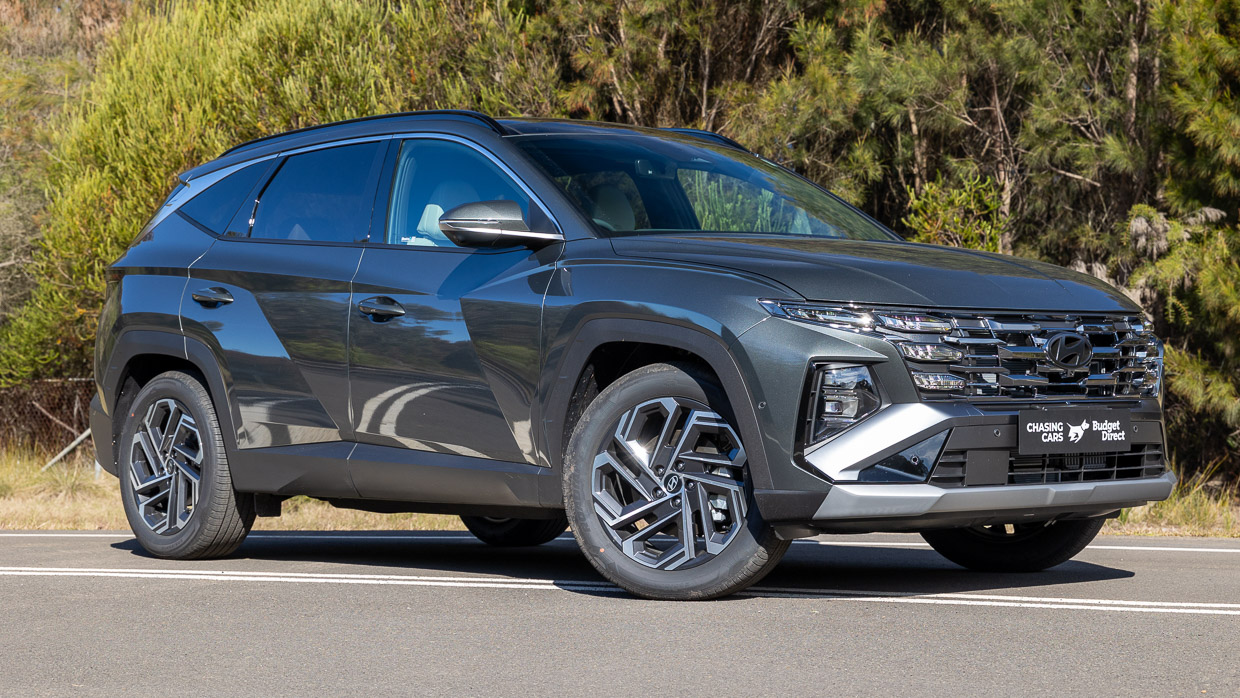
Regardless, the Hyundai Tucson Premium Hybrid AWD, and the broader facelifted range, should be welcomed as positive updates to an important segment.
More choice and more competition for vehicles such as the Toyota RAV4 is a good thing for everyone in any form, and the updated Tucson is seemingly worthy of the challenge.
May the fight for sales supremacy intensify. We’ll be watching the battle eagerly.
Key specs (as tested)
About Chasing cars
Chasing Cars reviews are 100% independent.
Because we are powered by Budget Direct Insurance, we don’t receive advertising or sales revenue from car manufacturers.
We’re truly independent – giving you Australia’s best car reviews.
The estimate provided does not take into account your personal circumstances but is intended to give a general indication of the cost of insurance, in order to obtain a complete quote, please visit www.budgetdirect.com.au. Estimate includes 15%^ online discount.
^Conditions Apply
Budget Direct Insurance arranged by Auto & General Services Pty Ltd ACN 003 617 909(AGS) AFSL 241 411, for and on behalf of the insurer, Auto & General Insurance Company Limited(ABN 42 111 586 353, AFSL 285 571).Because we don’t know your financial needs, we can’t advise you if this insurance will suit you. You should consider your needs and the Product Disclosure Statement before making a decision to buy insurance. Terms and conditions apply.
Indicative quote based on assumptions including postcode , 40 year old male with no offences, licence suspensions or claims in the last 5 years, a NCD Rating 1 and no younger drivers listed. White car, driven up to 10,000kms a year, unfinanced, with no modifications, factory options and/or non-standard accessories, private use only and garaged at night.
^Online Discounts Terms & Conditions
1. Discounts apply to the premium paid for a new Budget Direct Gold Comprehensive Car Insurance, Third Party Property Only or Third Party Property, Fire & Theft Insurance policy initiated online on or after 29 March 2017. Discounts do not apply to optional Roadside Assistance.
2. Discounts do not apply to any renewal offer of insurance.
3. Discounts only apply to the insurance portion of the premium. Discounts are applied before government charges, taxes, levies and fees, including instalment processing fees (as applicable). The full extent of discounts may therefore be impacted.
4. We reserve the right to change the offer without notice.